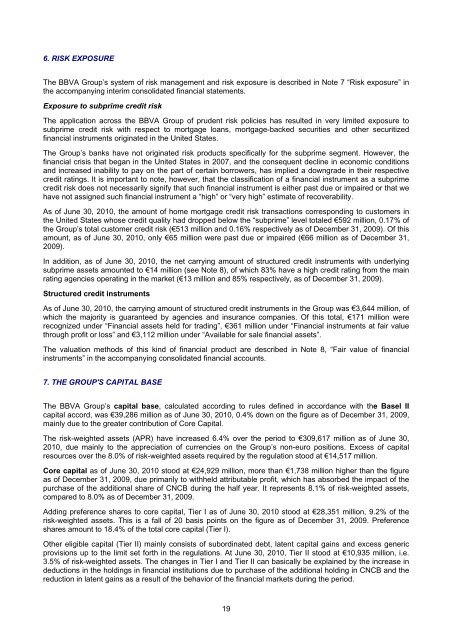BANCO BILBAO VIZCAYA ARGENTARIA, S.A. AND ... - BBVA
BANCO BILBAO VIZCAYA ARGENTARIA, S.A. AND ... - BBVA
BANCO BILBAO VIZCAYA ARGENTARIA, S.A. AND ... - BBVA
You also want an ePaper? Increase the reach of your titles
YUMPU automatically turns print PDFs into web optimized ePapers that Google loves.
6. RISK EXPOSURE<br />
The <strong>BBVA</strong> Group’s system of risk management and risk exposure is described in Note 7 “Risk exposure” in<br />
the accompanying interim consolidated financial statements.<br />
Exposure to subprime credit risk<br />
The application across the <strong>BBVA</strong> Group of prudent risk policies has resulted in very limited exposure to<br />
subprime credit risk with respect to mortgage loans, mortgage-backed securities and other securitized<br />
financial instruments originated in the United States.<br />
The Group’s banks have not originated risk products specifically for the subprime segment. However, the<br />
financial crisis that began in the United States in 2007, and the consequent decline in economic conditions<br />
and increased inability to pay on the part of certain borrowers, has implied a downgrade in their respective<br />
credit ratings. It is important to note, however, that the classification of a financial instrument as a subprime<br />
credit risk does not necessarily signify that such financial instrument is either past due or impaired or that we<br />
have not assigned such financial instrument a “high” or “very high” estimate of recoverability.<br />
As of June 30, 2010, the amount of home mortgage credit risk transactions corresponding to customers in<br />
the United States whose credit quality had dropped below the “subprime” level totaled €592 million, 0.17% of<br />
the Group’s total customer credit risk (€513 million and 0.16% respectively as of December 31, 2009). Of this<br />
amount, as of June 30, 2010, only €65 million were past due or impaired (€66 million as of December 31,<br />
2009).<br />
In addition, as of June 30, 2010, the net carrying amount of structured credit instruments with underlying<br />
subprime assets amounted to €14 million (see Note 8), of which 83% have a high credit rating from the main<br />
rating agencies operating in the market (€13 million and 85% respectively, as of December 31, 2009).<br />
Structured credit instruments<br />
As of June 30, 2010, the carrying amount of structured credit instruments in the Group was €3,644 million, of<br />
which the majority is guaranteed by agencies and insurance companies. Of this total, €171 million were<br />
recognized under “Financial assets held for trading”, €361 million under “Financial instruments at fair value<br />
through profit or loss” and €3,112 million under “Available for sale financial assets”.<br />
The valuation methods of this kind of financial product are described in Note 8, “Fair value of financial<br />
instruments” in the accompanying consolidated financial accounts.<br />
7. THE GROUP'S CAPITAL BASE<br />
The <strong>BBVA</strong> Group’s capital base, calculated according to rules defined in accordance with the Basel II<br />
capital accord, was €39,286 million as of June 30, 2010, 0.4% down on the figure as of December 31, 2009,<br />
mainly due to the greater contribution of Core Capital.<br />
The risk-weighted assets (APR) have increased 6.4% over the period to €309,617 million as of June 30,<br />
2010, due mainly to the appreciation of currencies on the Group’s non-euro positions. Excess of capital<br />
resources over the 8.0% of risk-weighted assets required by the regulation stood at €14,517 million.<br />
Core capital as of June 30, 2010 stood at €24,929 million, more than €1,738 million higher than the figure<br />
as of December 31, 2009, due primarily to withheld attributable profit, which has absorbed the impact of the<br />
purchase of the additional share of CNCB during the half year. It represents 8.1% of risk-weighted assets,<br />
compared to 8.0% as of December 31, 2009.<br />
Adding preference shares to core capital, Tier I as of June 30, 2010 stood at €28,351 million, 9.2% of the<br />
risk-weighted assets. This is a fall of 20 basis points on the figure as of December 31, 2009. Preference<br />
shares amount to 18.4% of the total core capital (Tier I).<br />
Other eligible capital (Tier II) mainly consists of subordinated debt, latent capital gains and excess generic<br />
provisions up to the limit set forth in the regulations. At June 30, 2010, Tier II stood at €10,935 million, i.e.<br />
3.5% of risk-weighted assets. The changes in Tier I and Tier II can basically be explained by the increase in<br />
deductions in the holdings in financial institutions due to purchase of the additional holding in CNCB and the<br />
reduction in latent gains as a result of the behavior of the financial markets during the period.<br />
19
















